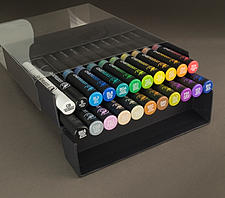This is a shockingly late, shameless promotion for all that is Ken Oliver. We’ve been Facebook buddies [like him here] for a little while (after all there aren’t that many gentleman crafters at shows and we need to stick together), and I have had the pleasure of saying hi a couple of times in person at trade shows. This February he was here in the UK promoting his new ‘own brand’ crafting goodies, and he was kind enough to do the whole selfie thing with me, demonstrate his new Color Burst watercolours and give me a promo pack of 12×12″ Studio series of papers and a 6×6″ sampler pack of his other papers.
I thought I’d use the 4×6″ journal cards sheet from his Studio collection to start off my new Project Life scrapbook, and they worked perfectly. The papers are printed on a satin finish light cardstock which feels smooth to the touch. There’s no bleed through from the Sharpies I used for some of the handwritten text, which is a bonus when working on double sided papers. As one might expect from an artist that’s been in the trade for years, the designs and colours used all work together beautifully. One slight hitch I noted when gluing things down – the satin finish does resist water-based liquids a little, as I found when I was using Zig Memory Systems two way acrylic glue. Something to be aware of, though that didn’t turn out to be too restrictive in practice – it might be more of an issue if spritzing with water/Color Burst (something I’ll test out).
Ken was also demonstrating his Color Burst watercolours. These are fine crystalline colours, conveniently dispensed from fine nozzle bottles. They appear to be similar to Brusho crystals (becoming very popular in the UK) in their reaction with water, both to make a watercolour paint, and in spritzing on the page to make vivid backgrounds. Where Color Burst beats Brusho, in my opinion, is the finer, more even crystal size and the fine nozzle capped bottle. I’ve knocked over a holed Brusho pot into my distress ink pad storage box, and the turquoise crystals continue to find their way into projects, much to the annoyance of my Tuesday night ladies… The reverse of my Project Life page shows a couple of samples from Ken’s beautiful Watercolored Memories 6×6″ papers (top left, bottom right), and the rest are Ken’s own demo sheets showing the vivid colours and dynamic reactions of the crystals with water on watercolour paper.
Thanks to Ken for having a chat, demoing his fabulous products, and especially for the goodie pack. Sorry it’s taken me so long to fulfil my promise to post about our chat!































